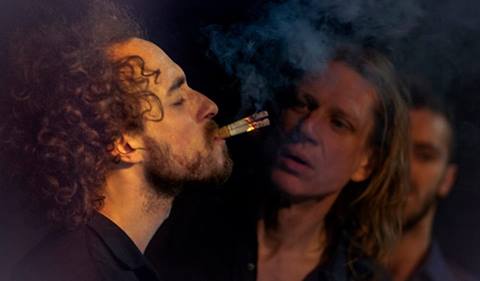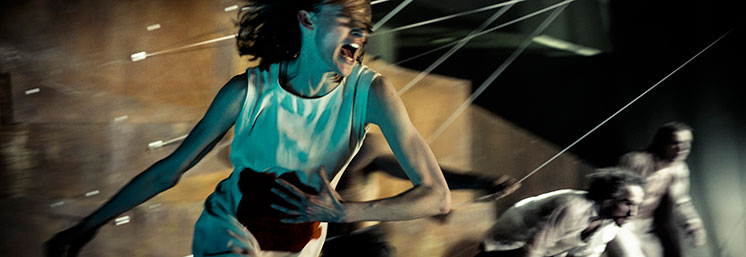One of the mottos made famous by internationally renowned chocolatier Willy Wonka was: “A little madness now and then is relished by the wisest men”. Perhaps it’s a quotation that Belgian choreographer Wim Vandekeybus, who put Talk to the Demon together, has framed on his wall. The piece is truly a trip, weaving down a barely trodden path between theatre, dance and art, ignoring narrative in favour of a free-flowing conceptual odyssey, rocketing the audience through exhilaration to tedium and back again. It doesn’t always work and it’s too long but I left the venue with my brain discombobulated in the finest manner, as only the wilder fringes of art can achieve.
The stage set features a row of rusted metal plates forming a wall on the left, and an odd Heath Robinson-esque wooden gadget on the right, with elastic lines reaching up from it to points in the ceiling. As the audience take their seats, a topless, paunchy man eyes them up, rolling around in an insectoid manner. From the start it's provocative, with the audience being asked to choose between two sweet-looking pre-teen children to play a lead role - Luke and Martha, their tee-shirts proclaim (De Bolle and Killick, respectively). We choose Luke but it turns out both children have equal time onstage and both are, incidentally, spookily deadpan and professional.
 The performance that follows is a series of vignettes, sometimes thematically connected in a way that’s comprehensible, sometimes not. The adult cast of four men and two women from Vandekeybus's Ultima Vez company are initially involved in a playground scenario, of fickle alliances and sudden, ruthless bullying, as in Dennis Potter’s Blue Remembered Hills. Vandekeybus has said he’s keen to move dance away from its reliance on music and this is a constant throughout. The troupe move as dancers, using their own percussive sounds and speech as rhythms, but also ostentatiously acting. In juvenile fashion they imitate each other, strip to their underwear, smoke cigarettes, throw stones noisily at the metal wall, but the childish scenario gradually moves from the comic to the ugly - manic laughter, howls, whipping and murder.
The performance that follows is a series of vignettes, sometimes thematically connected in a way that’s comprehensible, sometimes not. The adult cast of four men and two women from Vandekeybus's Ultima Vez company are initially involved in a playground scenario, of fickle alliances and sudden, ruthless bullying, as in Dennis Potter’s Blue Remembered Hills. Vandekeybus has said he’s keen to move dance away from its reliance on music and this is a constant throughout. The troupe move as dancers, using their own percussive sounds and speech as rhythms, but also ostentatiously acting. In juvenile fashion they imitate each other, strip to their underwear, smoke cigarettes, throw stones noisily at the metal wall, but the childish scenario gradually moves from the comic to the ugly - manic laughter, howls, whipping and murder.
One of Vandekeybus’s muses, who he has used in his films, is English actor Jerry Killick (father to Martha) and he has many speeches, telling the audience at one point that they chose “the wrong kid”. We chose “the shitty kid”. It’s taboo-breaking and funny, especially as Luke is there on stage, where he’s left for a brilliantly nightmarish sequence, one of the evening’s highlights, where one of the troupe, Elena Fokina, her hair over her face, becomes a monstrous slithering demonic mother figure, twitching about to a sinister, mesmerising, horror filmic soundtrack.
 There are many other highlights: Luke ordering the adults about so they become cows while he, a cowboy, rounds them up on one he has chosen to be his horse; Luke playing with the strange wooden object at the side of the stage, pinging it and plucking, creating amplified, electronically distorted sounds that the performers, all now attached to the roof by elastic, leap about to and interweave amongst each other; there’s a dementedly brilliant robot dance involving badmington rackets while Fokina rides around the stage on a tricycle, an abject figure akin to the grotesque puppet from the Saw films; and a battering, loud, explosive “war”, the stage a shadowplay of swirling light and movement.
There are many other highlights: Luke ordering the adults about so they become cows while he, a cowboy, rounds them up on one he has chosen to be his horse; Luke playing with the strange wooden object at the side of the stage, pinging it and plucking, creating amplified, electronically distorted sounds that the performers, all now attached to the roof by elastic, leap about to and interweave amongst each other; there’s a dementedly brilliant robot dance involving badmington rackets while Fokina rides around the stage on a tricycle, an abject figure akin to the grotesque puppet from the Saw films; and a battering, loud, explosive “war”, the stage a shadowplay of swirling light and movement.
There’s something of Antonin Artaud’s “theatre of cruelty” in it all, the way the audience is implicated, from a performer rushing across the front row to collect his own thrown underwear, to a clown questioning what we're thinking of him. It seems, somewhere within the visual overload, there's a question about the nature of human evil. Fortunately the extensive weirdness is often punctured by humour, dry one liners juxtaposed with the mayhem. Eventually however, it begins to pall and audience members start to leave.
Instead of saving the most animated sequences until last, the finale is slow and mournful; a death, an over-extended monologue about war (albeit accompanied by fascinating movement) and a lengthy, exceedingly slow conclusion involving clowns. The whole thing would have benefited from being at least 20 minutes shorter and, indeed, the programme indicated it had overrun by that amount. Nonetheless, the UK premiere of Talk to the Demon showcased a manic splurge of imagination which everyone from classical theatre to the summer's music festivals would do well to learn from.
Overleaf: Watch a very short documentary about Wim Vandekeybus and Talk to the Demon at the Brighton Festival














Add comment